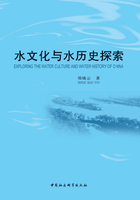
Introduction
China is an agricultural based country, but the documented urban history was dated back to more 4000 years. The early civilizations began in the middle and lower basin of Yellow River(Cai, 2012). Accordingly, in the early age of the Chinese cities, the major river nearby places were strongly considered as the site for building the city, especially rivers like Yellow River basin and Yangtze River basin. However, all the influential ancient cities in China were built close to the major rivers. They includes a series of the most influential ancient capital cities such as Anyang, Chang'an, Luoyang, Kaifeng, Nanjing, Hangzhou, Beijing, etc. For example, Anyang, the oldest capital city of China was built crossed the riversides of the old Heng Shui(洹水)river. Chang' an,today's Xi'an City, was built close to 8 rivers likes Wei(渭)、Jin(泾)、Lao(涝)、Feng(沣), etc, and became the capital city for 1700 years by thirteen dynasties. Kaifeng city was located between the Yellow River and Huai River. Nanjing city located at the south riverside of Yangzte River, etc.(Jin,2005). Being situated near rivers, the city had convenient water supply and irrigation system, which later also made transportation convenient. At the same time, it also faced high flooding risk from the rivers; accordingly, the ancient founders and governors of the cities always paid strongly attention to combat urban flood. Even later, many cities were built near the major canals, for example the Grand Canal Jinghan. However, the situation did not change(Teng et al. , 2012).
Basically, the early Chinese civilization was developed in the Yellow River basin. Accordingly, the major cities also developed in the Yellow River basin before Nan-Bai Dynasties(420—589 AD), but after Nan-Bai Dynasties, the major cities along the Yangtze River were developed. This outnumbered the Yellow River basin hundreds of years later, along with the economic development of the basin(Dong, 2004).
Rapid urbanization in China has become a wave beginning from the 1980s. It brought urban development into a new age, but at same time, it also ended the traditional urban water system through the construction of new water system during the process of enlarging and reconstructing the city widely. Most cities of China have changed their old form and structure of water system to this process. Anyway, the approach of urban reconstruction is currently the way of putting an end to the traditional urban form which includes water system. Unfortunately, more and more reconstructed cities are faced with rising water problems which include water shortage and pollution. In addition, frequently storm disaster has become a main challenge of the urban security in many cities in recent years. Nevertheless, this is because storm disaster in many old cities or the old part of the city was in less occurrence than in the new cities(Zheng, 2013). Consequently, this phenomenon requires us to rethink on the current construction of urban water system, questioning whether these impacts just reflect an incomplete infrastructure of the cities, or others which were disregarded. This can be viewed especially on the historical principle and heritage of urban water management. Therefore, the aim of this paper is to explore the construction of urban water system and its systematic feathers in ancient China, to study the wisdom and lessons from the history for the sustainable urban construction of water system for the process of rapid urbanization, and for a better understanding of the values of historical heritage of urban water management today.